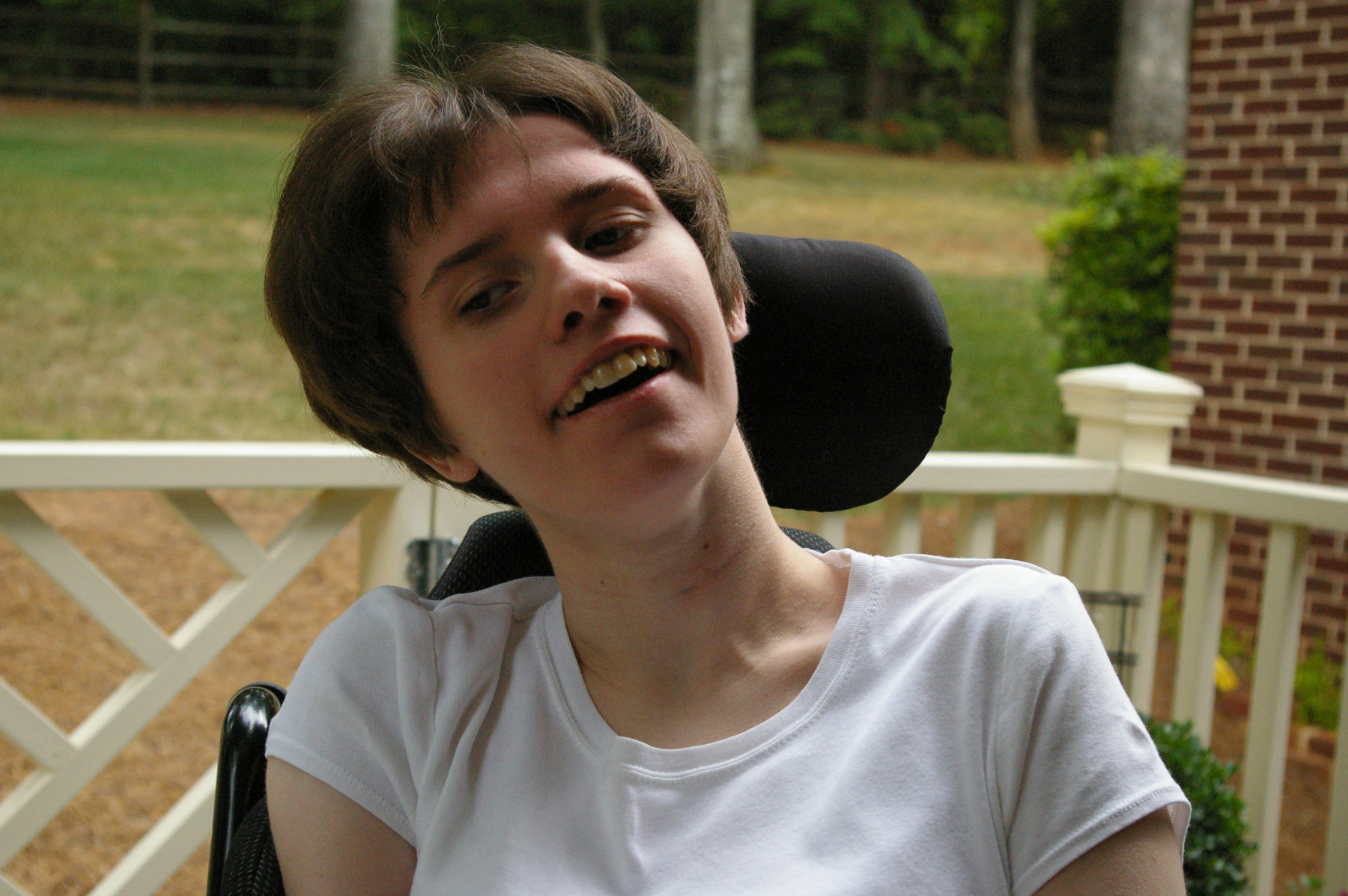CLN1 Clinical Guidelines Show More ‘Quiet Courage’ in Taylor’s Tale
Written by |

Taylor King at 16 years old. (Photo courtesy of Laura King Edwards)
Note: This story was updated Feb. 4, 2022, to correct the following information:
Laura Edwards worked in healthcare marketing. She gave birth to a child on the eighth floor of the hospital where her sister Taylor was being transferred to hospice care. Also, it was the nonprofit organization Taylor’s Tale that announced it would co-fund CLN1 and CLN2 research by Steven Gray, PhD.
Sharon King wished she had standardized clinical care guidelines when her daughter, Taylor King, who was 20 years old when she died in 2018 from neuronal ceroid lipofuscinosis type 1 (CLN1), was alive.
King remembers bringing Taylor into their pediatrician’s after-hours clinic because she was sick and feverish. The physician on call didn’t know anything about Taylor or her rare condition, so they stayed overnight in a hospital out of an abundance of caution. It turned out to be only a virus.
But having guidelines for CLN1, also known as infantile Batten disease, would have helped the doctor understand the situation and might have saved the time and expense of a hospital trip, King said.
“If only I had had access to this expertise, this knowledge from day one, it could have been a huge change-maker for Taylor’s best quality of life,” said King, who started the nonprofit Taylor’s Tale to fund research shortly after Taylor was diagnosed in 2006, in an interview with Batten Disease News.

Taylor King (center) flanked by her family. From left: sister Laura King Edwards, father Jim King, brother Stephen King, and mother Sharon King. (Photo courtesy of Laura King Edwards)
That’s one reason why it was important for King’s foundation to fund the report “Management of CLN1 Disease: International Clinical Consensus,” published in the journal Pediatric Neurology last year.
King hired a project manager and brought together 15 international experts to draft the guidelines. It all sprang from a conversation in 2016 between King and Margie Frazier, who at the time was executive director of the Batten Disease Support and Research Association.
As reported previously in Batten Disease News, a systematic review of published evidence was conducted to develop key statements, which were debated during a three-day advisory meeting in Durham, North Carolina, and supported by expert- and caregiver-specific online questionnaires.
The expert-specific survey was completed by 15 people from seven countries on four continents. These included 10 pediatric neurologists, a neuropsychologist, a metabolic specialist, a developmental physical therapist, a hospice nurse, and a social worker. The caregiver-specific survey was completed by 39 primary caregivers from six countries.
Statements reaching a consensus became care guidelines, which focused on 14 topics, including early diagnosis, seizures, movement disorders, vision problems, end-of-life care, and family support.
Seizure control was an important issue for King, who also is named as a co-author on the report. King always had to make a decision whether to layer additional anti-seizure medications onto Taylor’s regimen, which would make her sleepy and less alert, or watch her undergo more seizures. She was glad to see the paper discuss the difficult balance that parents face.
“Caregivers expect some amount of sedation to achieve better seizure control, but most prioritize maintaining alertness and the ability to interact over controlling seizures,” the study authors wrote based on the caregiver-specific survey results.
The study also addressed the use of non-pharmacological options, such as a ketogenic diet, to treat seizures. King said the diet helped her daughter, and three experts said they saw improvement with some of their patients.
King started Taylor’s Tale with her older daughter, Laura King Edwards, out of Charlotte, North Carolina, in 2007. Edwards, 39, lives two miles over the state line in South Carolina. Its primary focus was funding research that could lead to a treatment for Taylor, who was 7 when diagnosed with CLN1.
“It didn’t take me long to decide that Taylor’s illness was something I couldn’t just watch happen. I had to get involved,” said King, who also serves as manager of advocacy and community engagement at Aldevron, a biotech company.

Laura King Edwards completes the 2018 Charlotte half-marathon, weeks after Taylor King’s death and having her baby, Jack. (Photo by Dan Salvo)
Edwards, 24 at the time of her sister’s diagnosis, had just returned from her honeymoon. Her background in healthcare marketing would prove valuable to Taylor’s Tale, but so, too, would her running ability. Because of Taylor’s participation in Girls on The Run 5K races, despite her being blind, Edwards was inspired to start running (in some cases blindfolded) to raise awareness and money for Batten disease. She’s halfway through her goal of running races in all 50 states.
“My mom and I decided that day that we were not going to sit back and wait for this horrible thing to happen to Taylor and we certainly weren’t going to sit back and wait for other families to receive a similar diagnosis that came with literally no hope,” said Edwards, who also is a columnist for Batten Disease News, which is published by parent company Bionews Inc.
In 2007, the foundation funded its first project: an enzyme replacement therapy developed by Sandra Hoffman, MD, PhD, at the University of Texas Southwestern Medical Center. The therapy is now in preclinical stages with biotech company Collaborations Pharmaceuticals. In 2013, Taylor’s Tale announced it would co-fund CLN1 and CLN2 research by Steven Gray, PhD, who was an assistant professor at the University of North Carolina at the time, and now is an associate professor at UT Southwestern. The potential treatment, TSHA-118, recently started a Phase 1/2 clinical trial in Canada.
Taylor’s Tale also focused on policy change, advocating the introduction of North Carolina House Bill 823 to form the North Carolina Advisory Council on Rare Diseases. The bill was renamed Taylor’s Law in 2016.
King realized, however, there was more she could do apart from funding research. For patients who had no access to disease-altering treatment, relying on the best care in the clinic was all they had. An important resource for families and doctors was missing.
“If you can’t be a part of making a path so that they actually can be diagnosed to access that treatment, why are you doing this?” King asked. “So, we realized along the way, the importance of being involved as advocates. And we also realized that there were a lot of children, including Taylor, who would never benefit from that potential treatment, but they still deserve the best clinical care possible.”
Beyond giving physicians unfamiliar with Batten disease guidance for a plan of care, and patients a greater understanding of the condition, these clinical guidelines also can help inform clinical trial development, King said.
Both King and Edwards said Taylor would be proud of the progress they’ve made since she died in 2018. The mother-daughter duo is carrying on her legacy of determination in trying to have the best quality of life.
Edwards calls it “quiet courage.”
“Taylor just did everything and didn’t think twice about her disease being an obstacle or an excuse to not try,” Edwards said. “Taylor’s goal was to live a life not defined by Batten.”
Whenever Edwards runs a race, she feels as if Taylor is with her. Their lives have been tied together inextricably as sisters, but also through life. As Edwards was having her first child on the eighth floor of the hospital, Taylor was being transferred to the inpatient hospice (end-of-life) care unit on the second floor.
As its name suggests, remembering Taylor is central to the mission of the organization, and publishing papers like the clinical care guidelines.
“I think every day that we keep going, we are telling her story. It’s not about us. It’s really about Taylor and all of the children and families that are coming after her,” King said.







